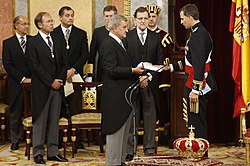Felipe VI
Felipe VI (Spanish: [feˈlipe ˈseɣsto][b], full name: Felipe Juan Pablo Alfonso de Todos los Santos de Borbón y Grecia; born 30 January 1968) is the King of Spain. He became king in 2014 following the abdication of King Juan Carlos.
| Felipe VI | |||||
|---|---|---|---|---|---|
 Felipe VI in 2023 | |||||
| King of Spain (more...) | |||||
| 19 June 2014 – present | |||||
| 19 June 2014 | |||||
| Predecessor | Juan Carlos I | ||||
| Heir presumptive | Leonor, Princess of Asturias | ||||
| Born | 30 January 1968
(aged 57) Madrid, Spain | ||||
| Spouse | |||||
| Issue | |||||
| |||||
| House | Bourbon[1][a] | ||||
| Father | Juan Carlos I | ||||
| Mother | Sophia of Greece and Denmark | ||||
| Signature |  | ||||
He is the third child and only son of King Juan Carlos I, and Queen Sofía. In 2004, Felipe married TV news journalist Letizia Ortiz, with whom he has two daughters, Leonor (his heir presumptive) and Sofía.
In accordance with the Spanish Constitution, as monarch, he is head of state and commander-in-chief of the Spanish Armed Forces with the military rank of Captain General, and also plays the role of the supreme representation of Spain in internationa relations.
Early life
Felipe was born at ORPEA Madrid Loreto in Madrid. He is youngest child and only son of former King Juan Carlos I and Queen Sofía of Spain. He had two sisters Infanta Elena, Duchess of Lugo and Infanta Cristina of Spain. He was baptized at Palace of Zarzuela in Madrid.
Felipe VI has studied at Centro Privado de Enseñanza Santa María de los Rosales. He accepted his high school education at Lakefield College School, and then studied Law and Economics at Autonomous University of Madrid. After that, he studied Foreign Service at Georgetown University.
Prince of Asturias
In 1977, he was given the title Prince of Asturias, the official title of the heir to the Spanish throne.
He received military training at General Military Academy and served in the military from 1986 to 2014.
King Felipe VI married Queen Letizia of Spain at Almudena Cathedral at 2004. They have two children together, Leonor, Princess of Asturias and Infanta Sofia of Spain.
Reign
On 2 June 2014, King Juan Carlos I announced that he would abdicate in favor of Felipe. Felipe became king on 19 June 2014 at 0:00 CET and was named Felipe VI.[2] A few days later after becoming king, Felipe became the first Spanish monarch to receive and recognize LGBT organisations at a royal palace.[3] Felipe also changed the protocol in order to allow people to take the oath of office without a crucifix or Bible.[4]
As King of Spain, Felipe VI performs a mainly ceremonial role with some reserved constitutional powers. In 2015, the general election resulted in no party winning a majority. King Felipe then dissolved parliament and called for another election.
In 2017, the regional government of Catalonia held an independence referendum and declared independence from Spain. The Spanish authorities deemed the referendum illegal. King Felipe delivered a televised speech in which he condemned the referendum for acting outside of the law.
In 2022, King Felipe and his wife attended the funeral of Queen Elizabeth II and also attended the coronation of Charles III the following year.
Titles and styles
- 30 January 1968 –1 November 1977: His Royal Highness Infante Felipe of Spain
- 1 November 1977-19 June 2014: His Royal Highness The Prince of Asturias
- 22 January 1977-19 June 2014: His Royal Highness The Prince of Girona, His Royal Highness The Prince of Viana, The Duke of Montblanc, The Count of Cervera, Lord of Balaguer, Infante of Spain
- 19 June 2014 – present: His Majesty The King of Spain
Felipe VI Media
Juan Carlos, Prince of Spain (left), with his son Felipe and his brother-in-law Constantine II of Greece (right) with his son Pavlos, 1968
In 1975, next to his parents, his older sister Cristina, and Alejandro Rodríguez de Valcárcel
King Felipe VI in 2015 with the JEMAD Admiral Fernando García Sánchez, JEME General Jaime Domínguez Buj and the Commander of the 7th Reconnaissance Cavalry Group of the VII Light Infantry Brigade "Galicia" (L–R)
Prince Felipe arriving for the third inauguration of Rafael Correa, 2013
Felipe VI presiding over the 2015 Princess of Asturias Awards in Oviedo
Felipe VI takes the oath before the Cortes Generales during the proclamation ceremony at the Palacio de las Cortes, Madrid, 19 June 2014.
Felipe VI chairing his first Council of Ministers, at direct request of prime minister Mariano Rajoy (18 July 2014).
King Felipe VI meets with US president Barack Obama at the Waldorf Astoria New York. 2014.
The King receiving the credentials from the Philippines ambassador Philippe Lhuillier, 2017
Notes
- ↑ The English-language version of the Official Royal Family website is rendered as "Borbon", while in Spanish it is rendered as "Borbón". In English, the house is traditionally called House of Bourbon.
- ↑ Most English-language media refer to the king as Felipe VI, although a few sources have rendered his name as Philip VI. In the languages of Spain, his name is:
- Aragonese: [Felipe VI] Error: [undefined] Error: {{Lang}}: no text (help): text has italic markup (help), IPA: [fe'lipe sej'seno]
- Asturian: [Felipe VI] Error: [undefined] Error: {{Lang}}: no text (help): text has italic markup (help), IPA: [fe'lipe 'sestu]
- Basque: [Felipe VI.a] Error: [undefined] Error: {{Lang}}: no text (help): text has italic markup (help), IPA: [felipe seiɣarena]
- Catalan: [Felip VI] Error: [undefined] Error: {{Lang}}: no text (help): text has italic markup (help), IPA: [fəˈlip siˈzɛ]
- Galician: [Filipe VI] Error: [undefined] Error: {{Lang}}: no text (help): text has italic markup (help), IPA: [fiˈlipɪ ˈsɛkstʊ]
- Spanish: Felipe VI, IPA: [feˈlipe ˈseɣsto].
References
- ↑ "His Majesty the King Juan Carlos". The Royal Household of His Majesty the King. Archived from the original on 18 February 2011.
- ↑ Spanish politicians lay out abdication timetable. BBC News. 2014-06-03. https://www.bbc.com/news/world-europe-27672997.
- ↑ (in es) Los reyes reciben por primera vez a colectivos gays en el Palacio del Pardo [The monarchs receive gay organisations for the first time at the Pardo Palace]. La Sexta. 24 June 2014. http://www.lasexta.com/noticias/nacional/reyes-reciben-primera-vez-colectivos-gays-palacio-pardo_2014062400197.html. Retrieved 17 July 2014.
- ↑ "Felipe VI cambia el protocolo y permite la jura del cargo sin Biblia ni crucifijo [Felipe VI changes the protocol and permits the oath of office without a Bible or crucifix"] (in es). El País. 9 July 2014. http://politica.elpais.com/politica/2014/07/09/actualidad/1404932149_211008.html. Retrieved 17 July 2014.









